Micro-transit helps public agencies improve transportation services while repurposing real estate assets for high-value uses.
The COVID-19 pandemic transformed the way we live and work in countless ways, with changes to our daily commuting patterns among the earliest and most visible. Driven by a rise in remote work and restrictions on public gathering, public transit ridership declined rapidly in early 2020. But while U.S. transit ridership remains about 50 percent below pre-COVID levels at press time, passenger car traffic has already recovered and, in some areas, even exceeds pre-COVID levels, undoing longstanding efforts to get cars off the road.
As office workers return to in-person work, the extent to which these commuting patterns revert to their pre-COVID trends will have profound implications for our economy and the environment. Let’s explore how innovations in transportation technology are helping boost transit ridership while building more affordable and sustainable communities.
Powering a New Commute
One such technology is micro-transit—an on-demand transit solution that provides shared rides in dynamically routed public vehicles. -Micro-transit, along with other technology-driven solutions such as shared bikes and scooters, unlocks the value of public land by reducing the need for single-occupancy vehicles and the parking lots that support them. As one example, consider how micro-transit and micro-mobility can improve access to commuter park-and-ride facilities.
According to some estimates, one in five transit commuters in the U.S. uses park-and-ride facilities every day. For decades, these lots have played a key role in allowing commuters to access public transit: commuters drive from home to a nearby rail or bus station, park their car while they ride to work and back, and then after work, drive their car home from the station to complete the last mile of their commute. For the duration of each workday, these cars sit idle, occupying high-potential, scarce, transit-adjacent land that could be repurposed for a range of uses.
Introducing Micro-transit
Technology-driven alternatives like micro-transit offer public agencies an opportunity to revisit their parking strategies, generating a new source of revenue while providing commuters more convenient and sustainable station access. The Seattle metropolitan area presents one of the best examples of how micro-transit can improve station access, reduce congestion and avoid the need to build additional expensive parking lots. A service launched in 2019 by King County Metro offers riders a technology-enabled solution to streamline their daily commutes.
In an area where commuter park-and-ride lots often fill up before 7 a.m. on weekdays, Seattle-area commuters using the Link light rail system are picked up within a short walk of their homes in a shared micro-transit vehicle and dropped at a nearby rail station. The ride-sharing algorithm dynamically dispatches vehicles in response to real-time requests and efficiently aggregates multiple passengers heading to the same light rail station to make the most efficient use of system capacity, even in lower density areas. The “Via to Transit” trip is treated as a free transfer when riders pay using their Orca fare card, just as when a rider transfers between two public transit buses, or between a bus and a rail trip. Similar micro-transit services exist around the world, and are expanding rapidly.
Taking the Driver out of the Commute
For public agencies, a solution like Seattle’s can accommodate a growing number of transit riders without the need to acquire new land and expand parking facilities. Flexible, technology-driven solutions also help future proof investments in transit infrastructure. Looking toward the future, as autonomous vehicles increasingly arrive on the road — including in similar shared services like Arlington RAPID — and many young adults forego driver’s licenses, innovative station access modes will help agencies avoid large capital investments into structures that are rapidly becoming obsolete.
Understanding the True Cost of Parking
With alternatives to the Park and Ride commuting framework on the horizon, public agencies throughout the country are increasingly recognizing the opportunity cost of dedicating land to parking and taking steps to monetize their real estate assets. For example, the San Francisco Bay Area Rapid Transit District (BART) has already redeveloped its parking assets into more than 2,000 housing units and nearly one million square feet of office and retail space, with many thousand more planned or under construction. And BART is just one among many cities and transit authorities that have leveraged their property to promote transit-oriented-development (TOD), creating dense, mixed-use, walkable communities that provide needed housing units and generate significant revenue for infrastructure reinvestment.

Structured parking can be expensive to build and maintain—often more than $70,000 per space in some cities. This means that a requirement to build a 300-person garage could cost a city millions of dollars to construct while occupying land that could have been used for parks, shops and restaurants, or additional housing units.
These projects represent a major improvement in land use policy, but communities often resist developments that reduce the availability of local parking spots, forcing agencies to set aside a portion of the developable land for subsidized parking in the design of TOD projects. In fact, according to one study of TOD policies at American transit agencies, more than 70 percent of surveyed transit agencies considered or implemented structured parking at stations associated with joint development or TOD projects. Less than half had a formal policy in place to govern parking replacement decisions, leaving them vulnerable to local pressures at every decision-making juncture.
Structured parking can be expensive to build and maintain — often more than $70,000 per space in some cities. This means that a requirement to build a 300-person garage could cost a city millions of dollars to construct while occupying land that could have been used for parks, shops and restaurants, or additional housing units. Instead, the cities can allocate this land to its highest-value use, or remove requirements to build a minimum number of parking spaces on infill developments. They can then use a portion of the revenue generated from the project to fund sustainable mobility options like micro-transit.
Policy Solutions for Increased Land Value
Here, too, leading transit agencies are showing us that there is a better way. For example, the Chicago City Council recently updated its TOD ordinance to reduce minimum parking requirements for both residential and non-residential buildings. Importantly, these guidelines extended not only to Chicago Transit Authority and Metra commuter rail stations, but also applied to selected bus route corridors. And in approving BART’s latest TOD Performance Targets document, the Board of Directors not only eliminated minimum parking requirements in its developments, it went as far as to set maximum parking ratios for both residential units and office and retail space.
The biggest challenges of the next decade, from housing to transit, will require bold policy choices. By following in the footsteps of innovative agencies around the country, we can begin to reverse decades of car-based choices and build the livable, sustainable communities that we need for the next decade and beyond.
istock / lana stock, Unsplash / Gerrie van der Walt




